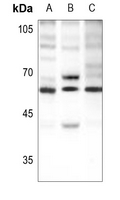Anti-Beta-2 Adrenergic Receptor (pS346) Antibody
Rabbit polyclonal antibody to Beta-2 Adrenergic Receptor (pS346)
- SPECIFICATION
- CITATIONS
- PROTOCOLS
- BACKGROUND

Application
| WB |
|---|---|
| Primary Accession | P07550 |
| Other Accession | P18762 |
| Reactivity | Human, Mouse, Rat, Bovine, SARS, Dog |
| Host | Rabbit |
| Clonality | Polyclonal |
| Calculated MW | 46459 Da |
| Gene ID | 154 |
|---|---|
| Other Names | ADRB2R; B2AR; Beta-2 adrenergic receptor; Beta-2 adrenoreceptor; Beta-2 adrenoceptor |
| Target/Specificity | KLH-conjugated synthetic peptide encompassing a sequence within the C-term region of human Beta-2 Adrenergic Receptor. The exact sequence is proprietary. |
| Dilution | WB~~WB (1/500 - 1/1000) |
| Format | Liquid in 0.42% Potassium phosphate, 0.87% Sodium chloride, pH 7.3, 30% glycerol, and 0.09% (W/V) sodium azide. |
| Storage | Store at -20 °C.Stable for 12 months from date of receipt |
| Name | ADRB2 |
|---|---|
| Synonyms | ADRB2R, B2AR |
| Function | Beta-adrenergic receptors mediate the catecholamine-induced activation of adenylate cyclase through the action of G proteins. The beta-2-adrenergic receptor binds epinephrine with an approximately 30- fold greater affinity than it does norepinephrine. |
| Cellular Location | Cell membrane; Multi-pass membrane protein. Early endosome. Golgi apparatus. Note=Colocalizes with VHL at the cell membrane (PubMed:19584355). Activated receptors are internalized into endosomes prior to their degradation in lysosomes (PubMed:20559325) Activated receptors are also detected within the Golgi apparatus (PubMed:27481942). |

Thousands of laboratories across the world have published research that depended on the performance of antibodies from Abcepta to advance their research. Check out links to articles that cite our products in major peer-reviewed journals, organized by research category.
info@abcepta.com, and receive a free "I Love Antibodies" mug.
Provided below are standard protocols that you may find useful for product applications.
Background
KLH-conjugated synthetic peptide encompassing a sequence within the C-term region of human Beta-2 Adrenergic Receptor. The exact sequence is proprietary.
If you have used an Abcepta product and would like to share how it has performed, please click on the "Submit Review" button and provide the requested information. Our staff will examine and post your review and contact you if needed.
If you have any additional inquiries please email technical services at tech@abcepta.com.













 Foundational characteristics of cancer include proliferation, angiogenesis, migration, evasion of apoptosis, and cellular immortality. Find key markers for these cellular processes and antibodies to detect them.
Foundational characteristics of cancer include proliferation, angiogenesis, migration, evasion of apoptosis, and cellular immortality. Find key markers for these cellular processes and antibodies to detect them. The SUMOplot™ Analysis Program predicts and scores sumoylation sites in your protein. SUMOylation is a post-translational modification involved in various cellular processes, such as nuclear-cytosolic transport, transcriptional regulation, apoptosis, protein stability, response to stress, and progression through the cell cycle.
The SUMOplot™ Analysis Program predicts and scores sumoylation sites in your protein. SUMOylation is a post-translational modification involved in various cellular processes, such as nuclear-cytosolic transport, transcriptional regulation, apoptosis, protein stability, response to stress, and progression through the cell cycle. The Autophagy Receptor Motif Plotter predicts and scores autophagy receptor binding sites in your protein. Identifying proteins connected to this pathway is critical to understanding the role of autophagy in physiological as well as pathological processes such as development, differentiation, neurodegenerative diseases, stress, infection, and cancer.
The Autophagy Receptor Motif Plotter predicts and scores autophagy receptor binding sites in your protein. Identifying proteins connected to this pathway is critical to understanding the role of autophagy in physiological as well as pathological processes such as development, differentiation, neurodegenerative diseases, stress, infection, and cancer.


